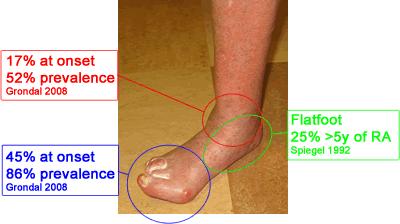The foot is a common site of problems in RA. It is not assessed by several of the disease activity activity scales, and foot disease may be less responsive to treatment than other sites (see above).

Typical reported prevalence of problems in different parts of the rheumatoid foot
Most studies report the ankle less affected; Michelson (1994) is the exception
Vainio (1956) described foot disease in nearly 90% of rheumatology inpatients (848 of 955 feet). In a systematic review, Jaakola and Mann (2004) found foot and ankle symptoms in 90% of patients with RA. Unlike most studies, Michelson (1994) found that hindfoot and ankle disease was commoner than forefoot disease but less likely to be treated. Grondal (2008) surveyed 100 patients attending Swedish rheumatology clinics. When their disease began, 45% had had foot problems and 17% ankle and hindfoot problems. At the time of the study, 86% had problems with the foot (comparable to 83% with problems in the hand), 52% in the ankle or hindfoot, and 45% in both. In the Early Rheumatoid Arthritis Study (Backhouse 2011), 10% had erosions in foot joints at trial entry within 2 years of disease onset. Otter found that quality of life was reduced in 93% of RA patients by foot problems: difficulties included walking, shoe choice, loss of mobility and independence. Turner (2008) found that patients with hindfoot disease (either alone or in combination with forefoot problems) had higher levels of disability and more abnormal gait than patients with forefoot disease alone.
Backhouse found that only 30% of rheumatoid patients had seen a podiatrist in the first 9y of their disease, although most had foot problems.
RA patients with foot disease are more disabled, have poorer quality of life and possibly more active general disease (Wickman 2004). Foot and ankle surgery in RA is more likely to be complicated by infection than surgery at most other sites (relative risk 3.2 - den Broeder 2007).
Although patients are tending to present with foot deformity but less joint damage, there have been no detailed reports of this change, and the series reporting joint-conserving surgery have not generally described the severity of joint damage.
Non-operative management of RA in the foot includes
- Physiotherapy
- Exercises can increase comfort and minimise disability in RA patients.
- A meta-analysis of the effectiveness of exercise therapy (Gaudin 2008) demonstrated improvements in muscle strength and aerobic capacity.
- Neuberger (2007) showed that the overall symptoms of fatigue, pain and depression in RA were improved by vigorous exercise
- Munneke (2004) found significantly less radiologic damage to the joints of the foot with high intensity weightbearing exercises than routine exercises
- Accommodative shoes (extrawidth/ extradepth)
- Padding over prominences
- Orthotics (custom made inserts or AFOs)
© 2008, 2010 East Lancashire Hospital NHS Trust. All rights reserved. Can only be reproduced in whole or in part for non-commercial purposes. Not to be reproduced in whole or in part without the acknowledgment of the author and the copyright holder.
